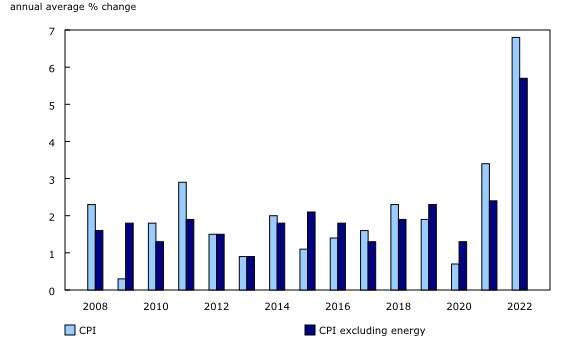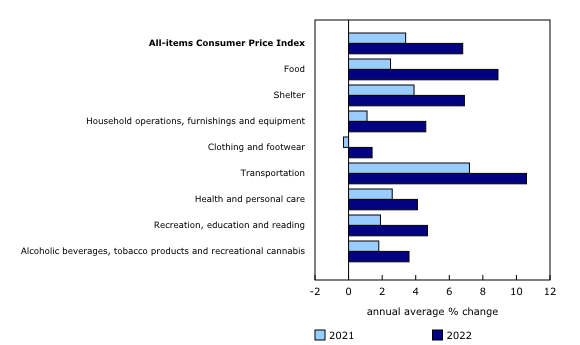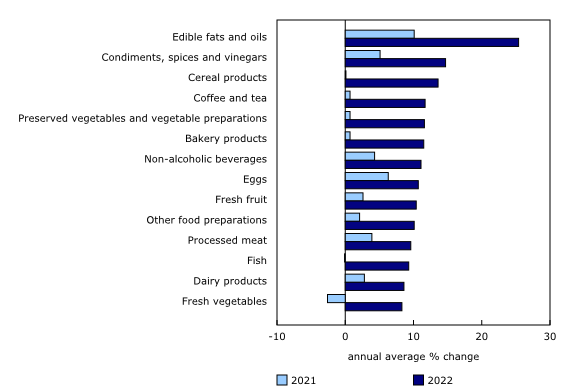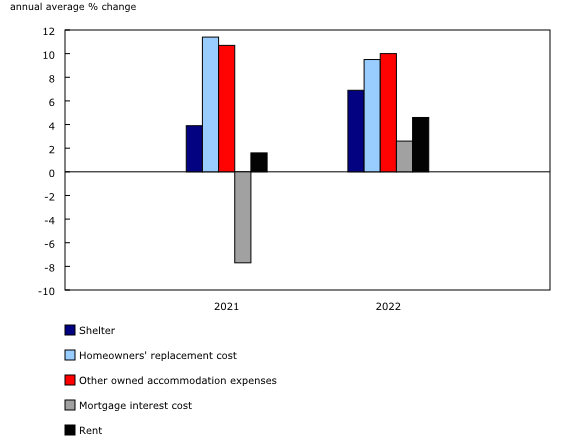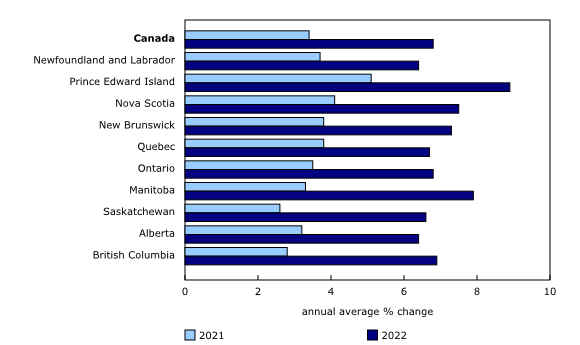Consumer Price Index: Annual review, 2022
Released: 2023-01-17
151.2
2022
6.8% 
(annual change)
The Consumer Price Index (CPI) rose 6.8% on an annual average basis in 2022, following gains of 3.4% in 2021 and of 0.7% in 2020. The increase in 2022 was a 40-year high, the largest increase since 1982 (+10.9%). Excluding energy, the annual average CPI rose 5.7% in 2022 compared with 2.4% in 2021.
Price increases were broad-based in 2022, with prices up on an annual average basis in all eight major components. Canadians felt the impact of inflation, as prices for day-to-day basics such as transportation (+10.6%), food (+8.9%) and shelter (+6.9%) rose the most.
Both goods and services prices rose at a faster pace compared with a year earlier. Prices for goods were up 8.7% on an annual average basis in 2022, led by higher prices for non-durable goods such as food purchased from stores (+9.8%) and gasoline (+28.5%). Prices for services increased 5.0% in 2022, led by homeowners' replacement cost (+9.5%) and other owned accommodation expenses (+10.0%).
Year-over-year price growth accelerated each month in the first half of the year, reaching a high of 8.1% in June, and slowed in the second half of the year.
Base-year effects and the Consumer Price Index in 2023
In the coming months, the relatively large month-over-month price movements that were observed from January 2022 to June 2022 will stop influencing the 12-month price movements in 2023. The broad increase in prices, led by prices for energy products, in the first half of 2022 will have a downward impact on the year-over-year rate of consumer inflation through the first half of 2023 because higher prices from 2022 will be used as the basis for year-over-year comparisons. For more information on the base-year effect, see the publication Consumer Price Index Fact Check: Measuring inflation during the COVID-19 pandemic and beyond.
Users should consider the impact of base-year effects when interpreting the 12-month price movements in 2023.
Higher energy prices contribute the most to headline inflation
Higher energy prices (+22.5%) contributed to the annual average headline inflation in 2022.
Consumers paid 28.5% more for gasoline on an annual average basis. Crude oil prices rose as a result of supply uncertainty amid Russia's invasion of Ukraine and higher demand in response to the easing of COVID-19 restrictions, pushing prices at the pump higher.
Prices for fuel oil and other fuels rose 59.6% on an annual average basis, following a 24.4% gain in 2021. Atlantic Canadians were most impacted by this increase, as fuel oil is more commonly used for heating homes in Atlantic Canada.
Prices for groceries rise at the fastest pace since 1981
Prices for food purchased from stores rose 9.8% in 2022, the fastest pace since 1981 (+12.0%), after increasing 2.2% in 2021. Food inflation was broad-based in 2022, with prices increasing on an annual average basis in every food category except for canned salmon (-1.4%).
Among others, higher prices for dairy products (+8.6%), other food preparations (+10.1%), fresh fruit (+10.4%), fresh vegetables (+8.3%), cereal products (+13.6%), and processed meat (+9.6%) contributed to the rise in grocery prices in 2022.
The supply of food was impacted by multiple factors, including extreme weather, higher input costs and supply chain disruptions. Russia's invasion of Ukraine created supply uncertainty in the global wheat market, putting upward pressure on prices for bakery products (+11.5%). Both countries are among the top 10 producers of wheat globally.
Shelter costs rise, led by homeowners' replacement cost
Shelter costs rose 6.9% on an annual average basis in 2022, led by higher prices for homeowners' replacement cost (+9.5%), which is related to the price of new homes, and other owned accommodation expenses (+10.0%), which includes commissions on the sale of real estate.
While the homeowners' replacement cost and other owned accommodation expenses indexes increased in 2022, they rose to a lesser extent than in 2021. Year-over-year growth in both indexes remained elevated during the early months of 2022 but have slowed every month since May, reflecting a general cooling of the housing market.
After declining in 2021, the Mortgage Interest Cost Index rose 2.6% in 2022 amid a higher interest rate environment in the latter half of the year.
Similarly, national rent prices increased 4.6% in 2022, following a 1.6% gain in 2021. The easing of public health measures in 2022, combined with post-secondary schools returning to in-person teaching and rising immigration, have contributed to higher rent prices.
Prices for durable goods remain elevated
Annual average prices for durable goods remained elevated, increasing 6.2% in 2022. Higher prices for passenger vehicles (+7.2%) contributed the most to the increase, partially attributable to the ongoing shortage of semi-conductor chips.
Although annual average prices for furniture (+11.6%) and household appliances (+9.0%) also rose in 2022, these indexes began to slow towards the end of the year. The slowdown is attributable to eased supply chain constraints, lower shipping costs and lower demand.
Prices for services rise at a faster pace
Prices for services rose at a faster pace in 2022 (+5.0%) than in 2021 (+2.3%), on an annual average basis, as public health measures eased and the economy fully reopened. In addition to shelter services, Canadians paid more for hotel rooms and restaurant meals.
Prices for traveller accommodation increased 29.3% on an annual average basis in 2022, after rising 2.2% in 2021. Increases were most notable in Ontario (+42.7%), Nova Scotia (+34.6%) and Quebec (+28.5%), reflecting increased demand for travel within Canada compared with 2021, when some COVID-19 restrictions were still in place.
In addition, higher annual average prices for food purchased from restaurants (+6.7%) in 2022 also contributed to the increase in services prices.
Regional highlights
Annual average prices rose in all provinces in 2022, but consumers in Prince Edward Island (+8.9%) felt it the most amid higher energy prices, such as fuel oil and other fuels (+68.1%) and gasoline (+34.0%). Manitoba (+7.9%) also recorded a notable increase, mainly driven by higher prices for homeowners' replacement cost (+22.0%).
Note to readers
This release examines the percentage change between the annual average Consumer Price Index (CPI) in 2021 and 2022.
Annual average indexes are obtained by calculating the average of the 12 monthly index values over the calendar year. The annual average percent change should not be confused with the 12-month percent change that is published every month with the release of the CPI. Unlike the annual average change, the 12-month change compares the monthly index level with the level from the same month a year earlier.
Explore the Consumer Price Index tools
Check out the Personal Inflation Calculator. This interactive calculator allows you to enter dollar amounts in the common expense categories to produce a personalized inflation rate, which you can compare to the official measure of inflation for the average Canadian household — the CPI.
Visit the Consumer Price Index portal to find all CPI data, publications, interactive tools, and announcements highlighting new products and upcoming changes to the CPI in one convenient location.
Browse the Consumer Price Index Data Visualization Tool to access current (Latest Snapshot of the CPI) and historical (Price trends: 1914 to today) CPI data in a customizable visual format.
Find the answers to the most common questions about the CPI in the context of COVID-19 and beyond.
COVID-19 and the Consumer Price Index
Goods and services in the CPI that were not available to consumers in January and February 2022 because of COVID-19 restrictions received special treatments, effectively removing their impact on the calculation of the monthly and annual average CPI. In March 2022 and onward, no special treatments for goods and services due to the COVID-19 pandemic were required.
The details of the special treatments from April 2020 to March 2021 are provided in technical supplements available through the Prices Analytical Series. Details and other treatment information for April 2021 to March 2022 are available upon request.
Correction
On January 30, 2023, select data points were updated to reflect the rounding rules noted above. The interpretation and analysis of the data are unaffected.
Products
The Consumer Price Index Data Visualization Tool is available on the Statistics Canada website.
More information about the concepts and use of the Consumer Price Index is available in The Canadian Consumer Price Index Reference Paper (62-553-X).
Contact information
For more information, or to enquire about the concepts, methods or data quality of this release, contact us (toll-free 1-800-263-1136; 514-283-8300; infostats@statcan.gc.ca) or Media Relations (statcan.mediahotline-ligneinfomedias.statcan@statcan.gc.ca).
- Date modified:

